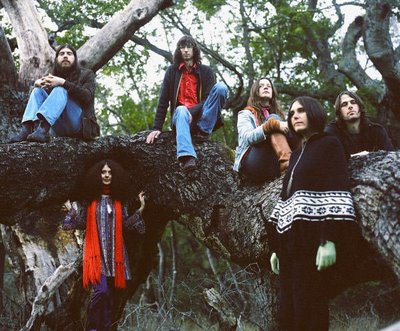Espers sailed through the Independent not long ago, spreading their ecstatic breed of folk rock tither and fro. I spoke to Meg Baird before the date, while she was getting ready for a show in the band’s hometown of Philadelphia.
SFBG: How did you approach this new album, III (Drag City)? Were you working with any particular narrative or set of images?
Meg Baird: We didn’t have anything that concrete as far as unified images go. We did kind of talk and get a sense of different places it would be coming from, especially in relationship to II. And we had a big hodgepodge of common ground where we thought it might come from.
We thought about things like new world colonialism, things being above ground instead of underground, something that would be a good counterpoint to the dense underworld of II. Something had landed, in comparison to the space place that II generated. Exuberance, weird Christianization.
Just a common sense of images or feelings. We tend to just write when we write. It’s really loose, more of a guide, so it feels like there’s a sense to everything. Not so that it’s a hard and fast rule — it’s just a way to talk about things.
SFBG: One also gets a sense that there’s a narrative there?
MB: We’re really not that narrative. Again it’s just trying to find a common ground of images. I think even with thinking of things like ships, boats, The Heart of Darkness. It’s so big. It just makes a little more fun when we can come up with a palette of common things. It’s really about tone and sounds — the imagistic stuff is a fluffy way to talk about it. It’s always about tone and feel.
SFBG: So “Trollslända” is not about trolls?
MB: That’s actually a Swedish word for dragonfly. Helena [Espvall], the cellist in the band, is Swedish. We like to have a Swedish language nod in every record.
SFBG: How does Espers write songs?
MB: It’s very ensemble-based, that’s for sure. Which makes it a little tense. I think we have a slightly tense presence on the live front because things are pretty worked out and rehearsed but we’re kind of not sure how it’s going to work at any moment. Especially because the band’s not leader-based. It doesn’t have that dynamic to the band, even if someone is playing a lead part for us. It’s never gone that way for us in a live setting.
SFBG: What was the weirdest show ever for Espers?
MB: Something really weird happened at a beautiful show — formerly the HockHocking Festival in Nelsonville, Ohio. We were invited to play by Michael Hurley — it was a beautiful outdoor festival and somehow people got in a fight right by the stage. It was only happening on my side of the stage — I found it really upsetting that this throw-down fight was happening, especially since it was such an intense environment.
SFBG: Espers are paranormal creatures — is that something you folks believe in?
MB: It’s cool that that’s in there. The name is pretty simple — it’s a reference to a book that Greg [Weeks] had, a book thinking about intellectualism as a form of social deviancy. There was a chapter on a cult in North Carolina — they didn’t use their names. They just referred to themselves as espers.
SFBG: Members of Espers have worked with other performers like Vetiver and Vashti Bunyan — what brings you back together after those other projects?
MB: Wow, it would be hard to describe exactly, which is probably why we like it. There’s something there in the dynamic that we don’t get anywhere else. I don’t know. Now that we know each other so well, it’s just a known quality that there’s a dynamic coming only from the group. It definitely feels like a real collaboration, not just, there’s a leader and here’s a song and back it up. I guess that’s why we like it. It’s always going to be bigger than ourselves — you’re putting a lot into it, but it’s going to be more than the one thing you’re doing.
SFBG: The album art is so beautiful — what’s the story behind it?
MB: Oh, yeah, we’re so pleased with album art. That came from the goofy concepts I was telling you about in the beginning, when we were just getting a feel for the record. Brook [Sietinsons] had this book on a woman artist, Xavier Schipani — it seemed to jive with some of the things we were talking about. She did a new drawing based on ideas we were throwing around.
SFBG: It’s about community-building?
MB: I think it would be a little more cynical than that. It’s about colonialism, too. It’s not all good. Of course, when people were there they had to build community and all those things — we’re just looking at it in a realistic and nonromantic way.
I might be more interested in it because of my interest in early American music. That comes from a family connection. My family is all from Appalachia, from way back — that’s part of the reason why I got interested in folk music.
SFBG: If Espers could be a tree, what would it be?
MB: Probably something very, very high maintenance. Hopefully one that will live… long. That hung in there for a while and maybe had some use to humanity with shade or fruit or something useful rather than pure ornamentation.

